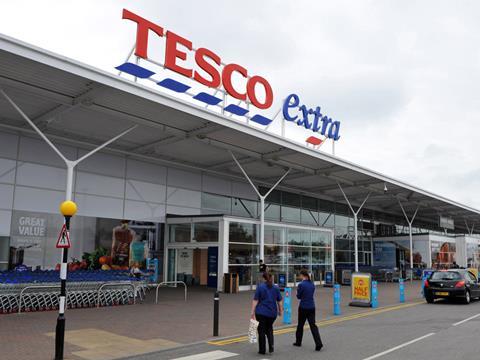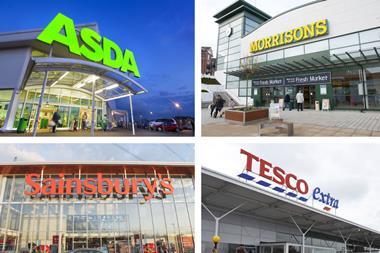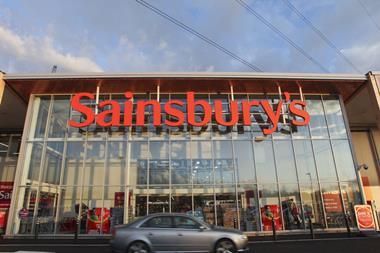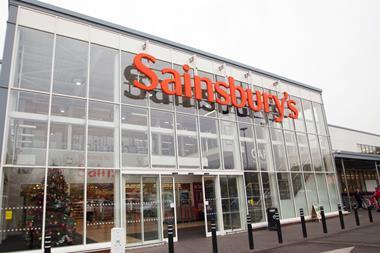
Top story
Tesco (TSCO) announced today it had “outperformed” the UK market over Christmas, with a 2.6% like for like increase in sales over the six weeks to 5 January.
Sales over Christmas in the core Tesco business were up 2.2%, with boss Dave Lewis claiming it has managed to achieve momentum going into the vital period after its heavy investment in the supermarket’s own label range.
Sales in the core Tesco UK business grew by 0.7% in the third quarter, a 12th consecutive quarter of growth, although Lewis said the figures had been hit by a “more challenging market.” Like-for-like sales in the UK & ROI business including Booker grew by 1.9% in the third quarter and 2.6% in the six-week Christmas period, Tesco revealed. During Q3 more than 74% of its 10,000 own brand products were relaunched with the roll-out of our ‘Exclusively at Tesco’ range 95% complete.
There was also a major revamp of marketing around the own label offer which it said had helped contribute towards sales.
Over Christmas Tesco said its ‘Festive 5’ vegetable sold nearly 20 million units over the three weeks to Christmas and saw like-for-like sales growth of 12.2% in total meat joints.
It also achieved a 3.8% year-on-year increase in Delivery Saver subscribers to 491,000, compared to Christmas last year.
The festive period also including its biggest week in sales in online grocery to date in the week before Christmas which saw nearly 51 million items delivered and 776,000 orders.
“As a team we have achieved a lot in the last 19 weeks,” said Dave Lewis. “ In the UK we delivered significant improvements in our competitive offer and this is reflected in a very strong Christmas performance which was ahead of the market.
“In Central Europe, the reshaping of our business continues and we are confident of the outcome we envisaged. In Asia, negotiations with suppliers are concluding satisfactorily and we can see this in our simpler, clearer, more impactful offer for customers.
“We have more to do everywhere but remain bang on track to deliver our plans for the year and as we enter our centenary we are in a strong position.”
Tesco shares are up 1.2% to 214.2p on the news.
Morning update
Retailers have suffered their worst Christmas for a decade according to new figures from the BRC and KMPG.
In a week of crucial results for a raft of major retailers, the organisations’ retail monitor recorded total sales growth of 0.0% in December, compared to a 1.4% increase 12 months ago.
The gloomy figures also showed the lowest monthly growth since April, excluding Easter distortions, and were below the three-month and 12-month averages of 0.5% and 1.2% for the year respectively, making them the worst December results since 2008.
However, whilst the figures set alarm bells ringing across the retail industry, there was a stronger performance from the food sector compared to non-food sales.
Over the three months to December, food sales increased 0.6% like for like, although this was below the monthly average growth of 3.1%.
Yet the overall results led to calls from retail leaders for urgent help from the government.
“Squeezed consumers chose not to splash out this Christmas with retail sales growth stalling for the first time in 28 months,” said Helen Dickinson, BRC chief executive.
“The worst December sales performance in 10 years means a challenging start to 2019 for retailers, with business rates set to rise once again this year, and the threat of a no-deal Brexit looming ever larger.
“The retail landscape is changing dramatically in the UK, while the trading environment remains tough. Retailers are facing up to this challenge but are having to wrestle with mounting costs from a succession of government policies – from the apprenticeship levy to higher wage costs to rising business rates.
“Growth in food did provide a glimmer of hope, being among the few categories to notice an uptick,” said Paul Martin, UK head of retail at KPMG.
He said the figures came despite “desperate” retailers’ attempts at price slashing which he said had “seemingly not been enough to encourage shoppers”.
He added: “The continued contrast in performance between the high street and online remained evident in December – albeit 2018 did also see a continued slowdown in online retail sales.
“The first months of 2019 will unlikely hold much improvement. As many retailers report their festive trading performance, the list of winners and losers will become clear, but winning means more than just improving sales. Retailers have to protect their margins in order to deliver a profitable festive season.”
Grocery and general merchandise sales continued to slide over the Christmas period at Marks & Spencer (MKS), which reported a 2.2% drop in overall UK like for like sales in the 13 weeks to 29 December.
Food like for like sales dropped 2.1% in M&S’ third quarter and by 1.2% on a total basis to £1.68bn.
M&S said this revenue drop reflected “price investment and the transition to trusted value” and that it had seen “early signs of volume improvement and solid growth” over the Christmas weeks.
Clothing and home sales dropped by 2.4% on a like for like basis and by 4.8% in total to £1.1bn.
The continued weakness in general merchandise reflected lower footfall to stores, partly as a result of increasing pace of closures and a 25% reduction of stock into sale. However, it reported online growth of 14% driven by improvements to proposition and operations.
International revenues were down 15.1%, but were down a more modest 1.4% excluding impact of the sale of its Hong Kong business and the closure of stores in loss making markets.
CEO Steve Rowe commented: “Against the backdrop of well publicised difficult market conditions our performance remained steady across the period. Our Food business traded successfully over Christmas as customers responded to improved value. Our transformation programme remains on track.
“The combination of reducing consumer confidence, mild weather, Black Friday, and widespread discounting by our competitors made November a very challenging trading period. However, overall our 13-week performance was steady with some early encouraging signs.
“In clothing & home we are at the early stages of far reaching changes in range, in style, customer focus and channel mix. Our objective is to reshape our buy, deliver market leading value and focus on stylish and wearable wardrobe “Must-Haves” as we grow our business with family aged customers seeking style, quality and value.
“In food we started on a journey to re-engineer the range and value proposition six months ago and are now making good progress. The underlying trend reflects the transition to ‘trusted value’ as we lower prices and remove complex and confusing multi-buy promotions. There are early signs of volume growth and we expect to see more momentum under a strong new management team as the year progresses.
“Customers responded well to our Christmas ranges and campaign resulting in solid volume growth over the Christmas period, with the majority of stores delivering like-for-like revenue growth.”
M&S’ full year guidance remains unchanged ahead of its full year results in May.
The John Lewis Partnership has reported modest growth over Christmas, with incremental progress across both its John Lewis and Waitrose brands.
Waitrose & Partners gross sales (excluding fuel) were £1,05bn, up 0.2% versus last year and up 0.3% on a like-for-like basis, despite reduced promotional activity.
John Lewis & Partners gross sales were also up 2.5% to £1.16bn in the 7 weeks to 5 January, representing like-for-like growth of 1% and outperforming the wider market by 2%.
Total gross sales at the John Lewis Partnership were up 1.4% versus last year to £2.2bn.
The group said Waitrose is on track to deliver full year profit growth. It said the grocer offered “a strong and innovative product range” and that a “well-planned, smooth-running operation and good availability” helped drive growth.
Waitrose saw particularly strong growth online at 12.8%, while in-store customer satisfaction improved “significantly” year-on-year due to improvements in stock availability, service quality and ease and speed of the checkout process.
John Lewis’ sales growth occured despite significant outperformance of the market last year, with notably strong trading in Fashion, particularly in Womenswear and Beauty.
The trading period was defined by a longer Black Friday promotion, a “very strong” week running into Christmas including a record Christmas Eve in shops and an “encouraging” first week of clearance.
Fashion sales were up 6.8%, while beauty was up 11.2%. Technology “continued to be popular” while it had a record year for gift food.
We continue to make good progress with both our own-brand and exclusive products with particularly strong performance in own-brand Womenswear, up 14.7%.
JLP chairman Sir Charlie Mayfield said: “Two main factors are affecting the retail sector - oversupply of physical space and relatively weak consumer demand. Despite this, we had a positive Christmas trading period thanks to the extraordinary efforts of Partners in our business, delivering differentiated products and service to customers.
“Waitrose & Partners achieved the best operational performance we have seen for some years, with good availability, low wastage and partners focused on providing better customer service. Like-for-like sales increased, despite a sharp reduction in the level of promotions as we focused on our most loyal customers. We are well on track to grow Waitrose & Partners’ profits for the full year.”
However we warned that the group continues to expect overall profits will be “substantially lower this year, driven by slower sales growth over the year and margin pressure in John Lewis & Partners along with higher costs, mainly as a result of our continued investment in our IT capability”.
He added: “The actions taken in recent years to prepare for the current pressures in retail mean that the Partnership has the financial strength and flexibility to pay a modest bonus this year, without impacting our ambitious investment programme.
“However, the board will need to consider carefully in March, following the usual process, whether payment of a bonus is prudent in the light of business and economic prospects at that time.”
Elsewhere on a hectic morning, B&M UK (BME) saw like for like sales drop 1-6% in its third quarter despite a 1.2% uplift in December, according to a trading update this morning.
The retailer said a strong December followed a “disappointing” November. The like for like sales decline also followed a strong performance in the comparable period the year before, when the figure rose 3.9%.
The business remained on track to deliver a record year for sales and earnings, according to B&M European Value Retail S.A chief executive Simon Arora.
Revenue for the group, including Heron Foods, Jawoll and Babou, grew 12.1% to £1,087.1m, compared to a 22.9% rise the year before. The period saw a net 20 stores opened.
The retailer said December’s positive sales momentum had continued into January and careful inventory control meant stocks for the end of season sale were below last year’s levels, promising further support to the margin over quarter four.
B&M UK revenues rose 4.5% to £874.5m in 13-week period.
Heron Foods grew revenues by 12.6% to £89.9m, opening nine new stores net.
Jawoll revenue rose 4.9% to £55.3m, with three new stores and good performance in categories benefiting from B&M’s Far East supply chain including toys and electricals. However the strong performance in those categories was offset by falling sales in the clothing category, on which Jawoll had been reducing its reliance.
Babou, which the group acquired in October 2018, contributed £67.3m of revenues in the quarter, with the clearance of existing merchandise ahead of the arrival of B&M sourced products from March 2019 onwards.
“Despite the broader economic uncertainty over the last quarter, B&M is on track to deliver a record year for both sales and earnings, representing our fourteenth consecutive year of profit growth,” said Arora.
“The business’ ability to manage profitability through uncertain trading conditions is testament to the resilience of the business model and the strong operational controls we have in place. We continue to open new stores and win market share when other retailers are retrenching.
“I would like to thank all our colleagues across our UK, German and French businesses for their hard work and commitment over our busiest ever peak Christmas period. I am pleased by the December trading and the positive momentum with which we enter 2019. We look forward to the year ahead with confidence as our value proposition is clearly resonating with shoppers.”
C&C Group (CCR) has announced that trading across the group for the four months to 31 December 2018 has been in line with expectations, including through the key Christmas trading period.
Operational delivery and customer service at both Matthew Clark and Bibendum have been “very strong and ahead of plan”, meaning the acquisitions are on plan to deliver a financial contribution to its full year results.
Across the rest of the group, positive trading momentum has continued into the second half, with revenues tracking mid-single digit ahead of last year, meaning it expects to deliver full-year results to 28 February 2019 in line with the board’s expectations.
Stephen Glancey, CEO, commented: “Despite the current political uncertainty the Group is increasingly well positioned going into 2019. The new management teams and colleagues at Matthew Clark and Bibendum, have delivered an exceptional operating performance over the key Christmas period.
“With service levels restored, we now have stable platforms with real growth potential and unparalleled market access to the UK on trade. In Scotland and Ireland our combination of leading brands and distribution assets is highly resilient, cash generative and delivering growth. With a strong balance sheet and normalised cash flow conversion of 60-70% of EBITDA we are poised to provide enhanced shareholder returns.”
Household goods supplier McBride (MCB) grew revenues by 10.8% in the six months ended 31 December 2018.
Excluding the benefit of first quarter revenues from Danlind, continuing underlying revenues were still 6% higher. Underlying Household division sales were 5.9% higher, primarily as a result of higher sales in the East and UK regions (up 23.4% and 10.5% respectively).
It said at its recent AGM that the first half year saw raw material, packaging and logistics costs higher than anticipated, particularly in the second quarter. These have been partly mitigated by improved sales volumes and lower overheads and the pricing outlook for many of our key raw materials has improved recently.
In the absence of this reversing significantly, the board expects full year earnings to be in line with expectations, with full year profit delivery weighted to the second half.
CEO Rik De Vos said: “”The group has made significant strategic progress in the first half of this financial year completing the sale of Personal Care Liquids, integrating Danlind onto the McBride systems and managing our revenue growth.
“Margins remain our key focus at present and the recent improvement in the pricing outlook for raw materials following almost two years of significant inflation will see some recovery of the cumulative cost impact to the business. I remain confident that the group continues to be well positioned to exploit the growth and margin opportunities in the remainder of this financial year and beyond.”
Hilton Food Group (HFG) has issued a trading update for the 52 weeks ended 30th December 2018 ahead of its full year results on 27th March 2019.
It said it has performed in line with the expectations, with a continuation of the strong year-on-year sales growth driven by Seachill and its operations in Australia and reflecting growth in a number of existing and new markets.
In Western Europe, it has continued to grow the business, with higher turnover particularly in the UK and Ireland.
In the UK, there was steady growth in the red meats segment as well as a significant contribution from Seachill, which has also benefitted from the Tesco shellfish business.
In both Sweden and Denmark, sales were a little lower, though with strong Christmas fresh pizza sales in Sweden and emerging opportunities elsewhere. In Holland, although sales were lower, reflecting consumer demand, the group has continued to perform well, while the joint venture in Portugal is also continuing to show good progress.
In Central Europe, performance has continued to improve as expected in the second half of the year, while Hilton’s business in Australia has also progressed well, delivering strong year-on-year double digit growth.
Hilton said its trading outlook remains positive, with growth prospects underpinned by the expansion plans previously announced covering Australia, Central Europe and subsequently New Zealand, as well as further opportunities arising from the Seachill acquisition.
The group stated: “Hilton remains well placed to deliver continued growth over the medium term enhanced by further opportunities to develop our cross category business in both domestic and overseas markets.”
On the markets this morning, the FTSE 100 is down 0.4% to 6,878.5pts.
M&S is up 0.5% to 279.1p, B&M is up 1% to 313.7p, McBride is up 2.4% to 134.2p and Hilton Food Group is up 0.8% to 964p.
Early risers include Cranswick (CWK), up 4.1% to 2,862p, Sainsbury’s (SBRY), up 1.3% to 276p and Greggs, up 1.2% to 1,476p.
Fallers include WH Smith (SMWH), down 1.2% to 1,862p, Imperial Brands (IMB), down 1.1% to 2,380p and Associated British Foods (ABF), down 1.1% to 2,243p.
Yesterday in the City
The FTSE 100 continued its recovery yesterday, climbing a further 0.7% to 6,906.6pts as retail and consumer stocks continued to gain.
Sainsbury’s (SBRY) was up 2.3% to 272.6p despite announcing a 1.1% fall in like-for-like sales over the Christmas period as investors were encouraged by core grocery growth of 0.4%. Fellow supermarkets Morissons (MRW) and Tesco (TSCO) were both up 1.8% to 216.5p and 211.8p respectively on the news.
Gregg’s jumped a further 6.7% to 1459p after pushing up its profit estimates for the year, after like-for-like sales in the fourth quarter jumped 5.2%.
Majestic Wine (WINE) also surged 5.6% yesterday to 264p after announcing strong Christmas sales, while Nichols (NICL) was up 8.3% to 1,560p after it reported a 6.9% jump in sales to £142m for the year ended 31 December 2018.
Other strong risers included Science In Sport (SIS), up 4.7% to 56p, DS Smith (SMDS), up 3.2% to 334.20p, FeverTree (FEVR), up 2.8% to 2,467p, Greencore (GNC), up 2.7% to 190.2p, Imperial Brand (IMB), up 2.6% to 2,407p and WH Smith (SMWH), up 2.4% to 1,885p.
The day’s few fallers included Hotel Chocolat (HOTC), down 5.1% to 272.5p, Devro (DVO), down 3% to 160.2p, McBride, down 2.2% to 131p, Finsbury Food Group (FIF), down 1.4% to 104.5p and McColl’s (MCLS), down 1.1% to 55.4p.



















No comments yet